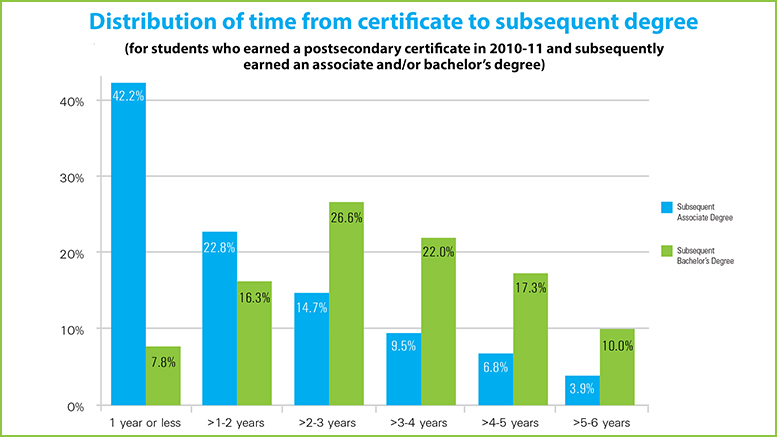About 41 percent of community college associate-degree completers go on to earn a bachelor’s degree, according to a new Snapshot Report from the National Student Clearinghouse Research Center.
The report looks at the 2010-11 academic year, during which 575,067 associate degrees were earned by students with no previous degrees or certificates.
“Within the next six academic years, 65.1 percent of these students enrolled at four-year institutions and 41.4 percent earned bachelor’s degrees,” the report’s authors say.
Most of those associate-to-bachelor’s completers were students in the 20-and-under age group and they completed their bachelor’s degree within three years.
Also during the 2010-11 academic year, a reported 264,013 certificates were earned by students with no previous degrees or certificates. About 63 percent of those students opted to enroll for additional college courses. Nearly 27 percent eventually earned an associate or bachelor’s degree — or both. Again, the largest group to earn those degrees was the 20-and-under age group.
Editor’s note: This article comes from the AACC 21st-Century Center.
Going from a certificate to an associate degree took less than three years for 80 percent of completers. And of those going from a certificate to a bachelor’s degree, 72 percent completed within four years.
While women and men completed the associate-to-bachelor’s pathway at about the same rate, slightly more women than men went from a certificate to an associate and/or bachelor’s degree.
The bigger picture
These numbers — while positive — only tell part of the story. While the students in the NSC Research Center study were able to complete a bachelor’s degree in a fairly timely manner after completing at a two-year college, getting to that first point — the associate degree — can take years for many.
After six years in a two-year program, only about 40 percent of full-time students earned an associate degree. Completion rates for part-time students are lower.
“The greatest indicator of future success is past success,” said Kent Phillippe, associate vice president of research and student success at the American Association of Community Colleges.
There also are a number of students who start at a community college and finish at a four-year college or university without ever having completed a certificate or associate-degree program. When students leave community college before graduating, they aren’t counted in the institution’s completion rates.

